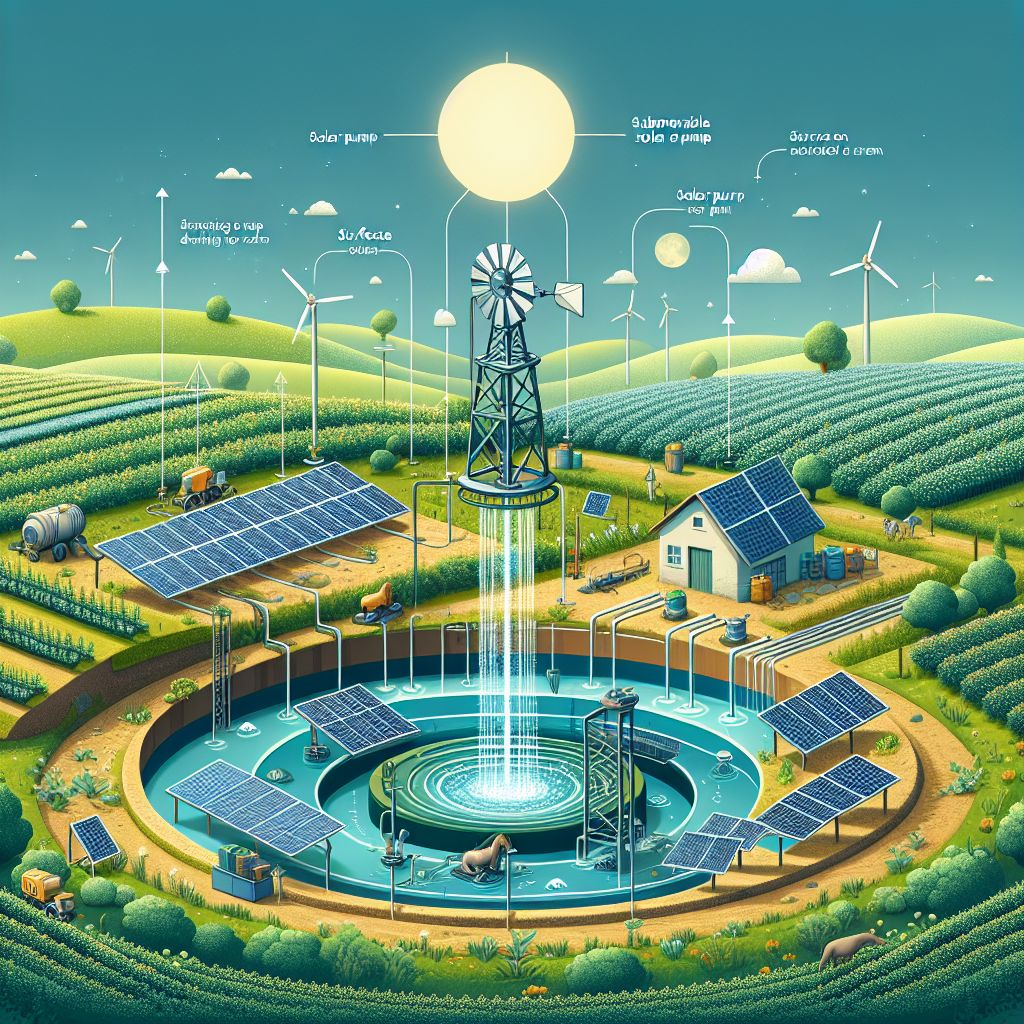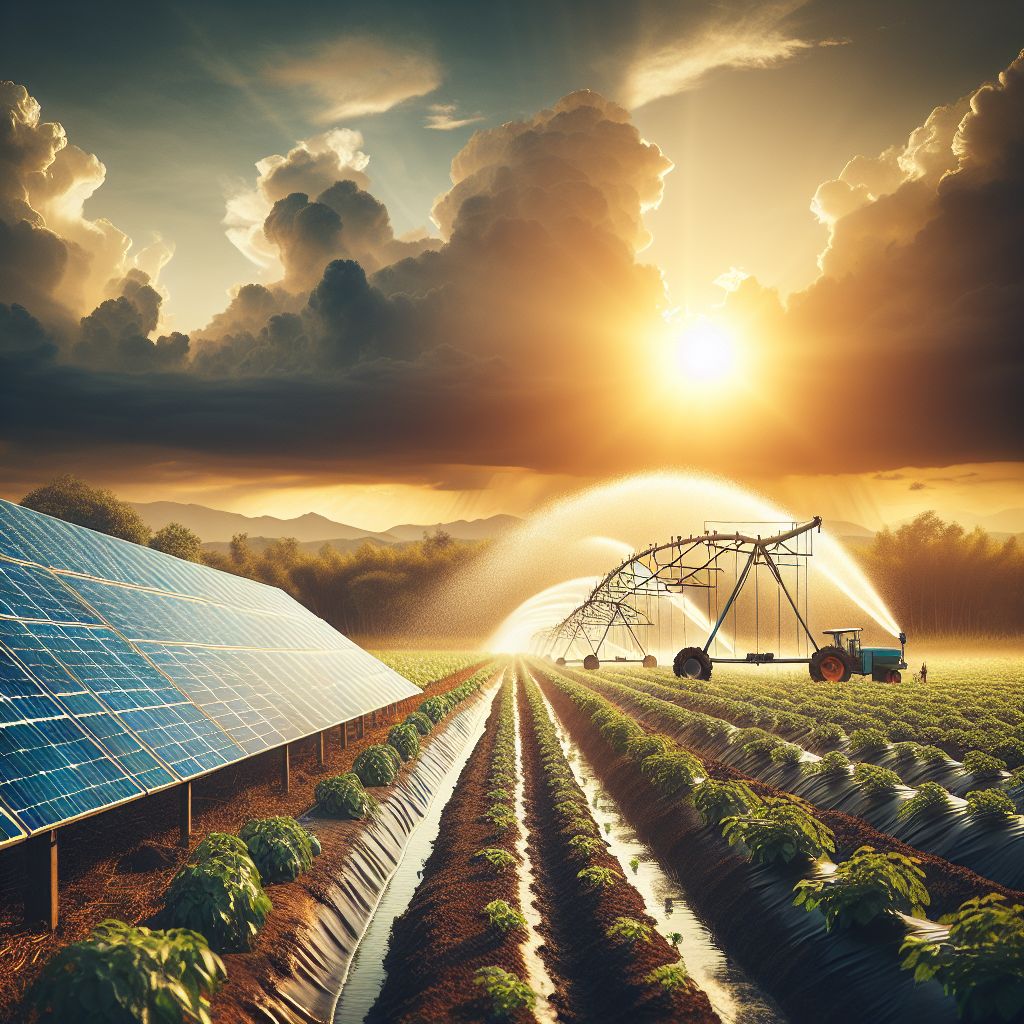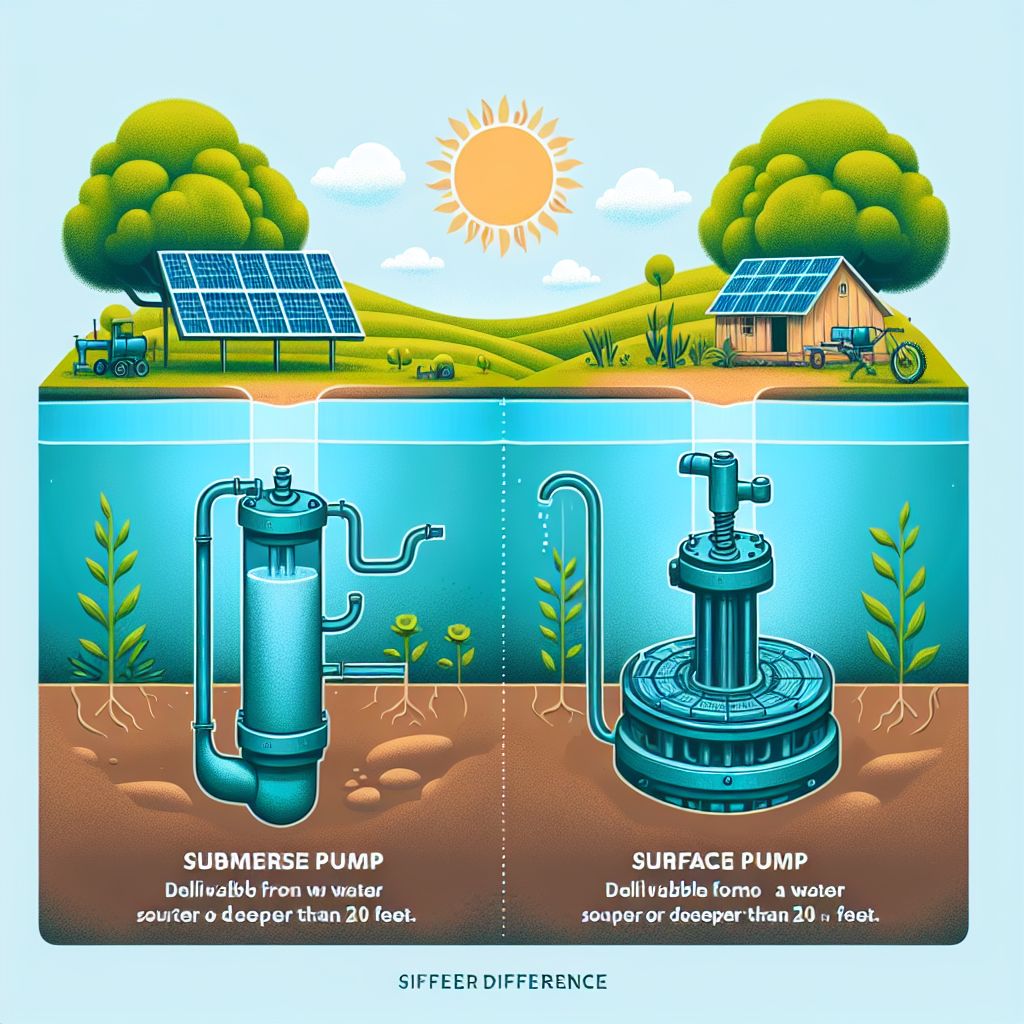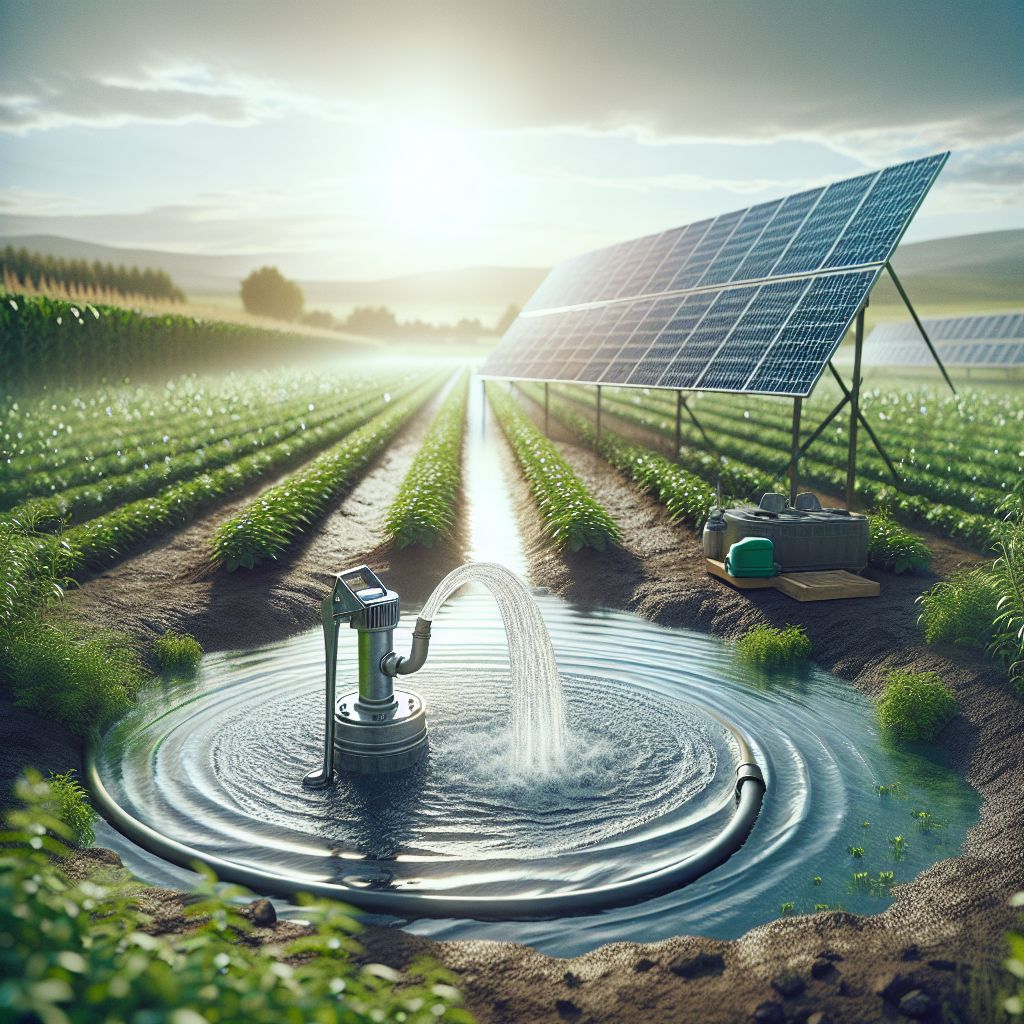
Key Takeaways: Choosing the Right Solar Water Pump
-
Solar pumps are a sustainable choice for irrigation, reducing dependence on non-renewable energy sources.
-
Two main types of solar pumps are available: submersible for deep water sources and surface pumps for shallow water.
-
To select the right solar pump, you need to consider the depth of your water source and the volume of water required.
-
Submersible solar pumps are more efficient for deep wells, while surface pumps are suitable for ponds and streams.
-
Installing a solar pump can lead to increased crop yields and is a cost-effective solution in the long run.

Solar Pumps: Empowering Sustainable Agriculture
As a farmer, you’re always looking for ways to increase productivity while being kind to the earth. Solar water pumps are a powerful tool in this quest. They harness the sun’s energy, a resource that’s both free and abundant, especially in rural, sun-drenched areas where farms are commonly found.
Why Solar Pumps are a Game Changer for Farmers
Imagine not having to worry about the rising costs of electricity or diesel to power your irrigation systems. That’s the reality solar pumps can offer. They’re not just eco-friendly; they can be a lifeline in areas where access to electricity is a constant challenge.
Core Benefits: Cost-Efficiency and Reliability
Let’s get straight to the point: solar water pumps can save you money. After the initial investment, the energy costs plummet to nearly zero. And when it comes to reliability, the sun is a pretty consistent power source. Sure, it’s not shining 24/7, but with the right setup, you can store enough energy to keep the water flowing even when it’s cloudy.
This below table outlining the benefits of solar water pumps for farmers:
|
Benefit |
Description |
|---|---|
|
Cost Savings |
Eliminates or reduces electricity bills and fuel costs for running traditional pumps, leading to long-term savings. |
|
Renewable Energy Source |
Utilizes sunlight, an abundant and renewable energy source, reducing dependence on non-renewable resources. |
|
Environmentally Friendly |
Reduces greenhouse gas emissions and environmental pollution compared to diesel or electric pumps. |
|
Low Maintenance |
Requires minimal maintenance compared to diesel or electric pumps, resulting in lower operational costs. |
|
Independence from Grid |
Provides independence from unreliable electricity grids, especially in remote rural areas. |
|
Increased Reliability |
Operates consistently in sunny conditions, ensuring a more reliable water supply for irrigation and other needs. |
|
Improved Crop Yield |
Ensures consistent water availability, leading to improved crop yields and increased agricultural productivity. |
|
Water Conservation |
Facilitates efficient water management by enabling precise control over water usage and reducing water wastage. |
|
Diverse Application |
Can be used for various agricultural activities such as irrigation, livestock watering, and aquaculture. |
|
Long Lifespan |
Generally has a long lifespan with minimal wear and tear, providing reliable service over many years. |
|
Government Subsidies and Incentives |
Availability of subsidies, grants, and incentives from governments and organizations to promote solar technology. |
|
Adaptability to Off-Grid Areas |
Ideal for off-grid and remote areas where access to electricity is limited or unavailable. |
|
Potential Income Generation |
Surplus energy generated by solar panels can be sold back to the grid, providing additional income for farmers. |
|
Climate Resilience |
Offers resilience against climate change impacts by providing a stable water supply despite erratic weather patterns. |
These benefits collectively contribute to enhancing agricultural sustainability, improving livelihoods for farmers.
Understanding Solar Pump Technology
So, how do these solar pumps work? They convert sunlight into electricity using solar panels. This electricity then powers a motor that runs the pump, drawing water from your source to where it’s needed on your farm.
Solar Panels and Power Requirements
It all starts with the solar panels. The size and number of panels you’ll need depend on how much water you want to pump and how far it needs to go. It’s a bit like filling up a bathtub with buckets; the more buckets you have, the faster you can fill the tub. In this case, the buckets are your solar panels, and the tub is your irrigation system.
The Mechanics of Solar Water Pumps
Inside the pump, there’s a motor and a mechanism that moves the water. This could be an impeller for surface pumps or a diaphragm for submersible pumps. The type of pump you’ll need depends on where your water is coming from. If it’s a deep well, you’ll want a submersible pump. If it’s a surface source like a pond or a stream, a surface pump will do the trick.

Selecting the Ideal Solar Pump for Your Farm
Choosing the right pump is crucial. You want to make sure it’s up to the task of meeting your irrigation needs without being overkill. It’s like picking out a tractor; you wouldn’t buy the biggest one if you only have a small field to tend to.
Types of Solar Pumps: Submersible vs. Surface
Submersible pumps are designed to be placed underwater. They’re perfect for deep wells or boreholes. Surface pumps sit above water and are great for shallower sources. Think about it like fishing; you’d use a different approach for deep-sea fishing versus casting a line in a shallow creek.
Most importantly, your choice between a submersible and a surface pump should be guided by the depth of your water source. If you’re drawing water from more than 20 feet deep, you’ll likely need a submersible pump. For anything shallower, a surface pump should suffice.
The table below will outline the main differences between submersible and surface water pumps for an irrigation system on a farm:
|
Feature |
Submersible Pump |
Surface Water Pump |
|---|---|---|
|
Installation |
Installed underwater in the water source (well, pond, etc.) |
Installed above ground near the water source (river, lake, reservoir, etc.) |
|
Depth Capability |
Suitable for deep water sources (e.g., wells) |
Limited to shallow water sources |
|
Priming Requirement |
Self-priming; no need for external priming |
Requires priming before operation |
|
Protection from Elements |
Protected from weather conditions as it’s submerged |
Exposed to weather conditions, may require additional protection |
|
Size |
Typically smaller and more compact |
Often larger and bulkier |
|
Maintenance |
Generally requires less maintenance as it’s protected from debris and weather |
May require more frequent maintenance due to exposure to debris and weather |
|
Suction Capability |
Capable of suction from deeper levels |
Limited suction capability compared to submersible pumps |
|
Energy Efficiency |
Generally more energy-efficient due to the hydraulic design |
May have higher energy consumption |
|
Noise |
Generally quieter as it’s submerged |
May produce more noise due to its location above ground |
|
Cost |
Initial cost might be higher |
Initial cost might be lower |
|
Lifespan |
Typically longer lifespan due to protection from elements |
Lifespan may be shorter due to exposure to weather and debris |
This table provides a general overview of the main differences between submersible and surface water pumps for farm irrigation systems. The choice between the two depends on various factors such as the depth of the water source, installation preferences, maintenance capabilities, and budget constraints.
Sizing Your Solar Pump: Calculating Water Needs
Getting the size right is about understanding your water needs. How much water do your crops need? How much sunlight do you get on average? You’ll want to have a system that can handle the peak demands of your farm, even on the hottest days when your crops are thirstiest.
Therefore, when sizing your solar pump, consider the following:
-
The total area of your farm that requires irrigation.
-
The type of crops you’re growing and their water requirements.
-
The amount of sunlight available throughout the year.
Remember, it’s better to have a little more power than you need rather than not enough. It’s like having a spare tire; you might not need it often, but you’ll be glad it’s there when you do.
Compatibility with Irrigation Systems
When integrating a solar pump into your farm, it’s essential to ensure compatibility with your existing irrigation system. This means considering the pressure and flow rate requirements of your sprinklers, drip lines, or other irrigation methods. The right solar pump should seamlessly fit into your system, providing the necessary water flow without overloading or underperforming.
Here’s what you need to check for compatibility:
-
The flow rate of the pump and the requirements of your irrigation system.
-
The pump’s pressure capabilities compared to what your system needs.
-
The compatibility of pump connectors and pipes with your irrigation infrastructure.
By aligning these factors, you’ll ensure your solar pump enhances your irrigation efforts rather than complicating them.

Using Submersible Water Pumps to Supply Water for Your crops
Submersible water pumps are a boon for farms with deep water sources. These pumps sit below water level, pushing water to the surface with efficiency and ease. They are particularly suited for deep wells, boreholes, and other similar water sources, providing a reliable flow of water for your crops.
Because they’re submerged, these pumps are out of sight and less susceptible to vandalism or theft, an added bonus for remote farm locations. They’re also quieter and tend to have a longer lifespan since they’re not exposed to the elements.
Positioning Submersible Water Pumps for Optimal Performance
For peak performance, submersible pumps must be correctly placed within the water source. This involves ensuring the pump is well below the water level, even during the driest seasons, to avoid drawing in air which can damage the pump. It’s also crucial to keep it off the bottom to prevent silt and debris from clogging the system.
Here are some tips for positioning your submersible pump:
-
Secure the pump at least 3 feet above the bottom of the water source to avoid sediment.
-
Ensure the water level will not drop below the pump during dry periods.
-
Consider the use of a floating platform to maintain the pump at the correct depth if water levels fluctuate significantly.
Benefits of Using Submersible Water Pumps
Submersible water pumps offer several advantages. They are efficient, with the ability to lift water from great depths, and they’re protected from the elements, which reduces wear and tear. Additionally, being underwater reduces noise pollution – a subtle but significant benefit for maintaining a peaceful farm environment.

Sometimes Surface Water Pumps Are the Best Option for Farmers
Not all farms require the heavy lifting of submersible pumps. For those with access to shallow water sources like streams, ponds, or lakes, surface water pumps are often the best choice. These pumps are easier to access for maintenance and are usually less expensive than their submersible counterparts.
When to Use Surface Water Pumps
Surface water pumps are ideal when your water source is within 20 feet of the ground surface. They work by pulling water up, which requires less energy than pushing water from below, making them a perfect match for solar power’s capabilities.
Here are scenarios when a surface pump might be your best bet:
-
If your water source is a shallow well, pond, or stream.
-
When you need to move large volumes of water over short distances.
-
If you prefer easy access to the pump for routine checks and maintenance.
Remember, the key is to match the pump to your farm’s specific needs, ensuring you’re not over- or underpowering your irrigation system.
Benefits of Using Surface Water Pumps
Surface pumps are not only cost-effective but also versatile. They can be used for a variety of applications, from irrigation to livestock watering. Their installation is straightforward, and because they are above ground, inspections and repairs are much simpler.
Real-World Impact: Case Studies
The proof is in the pudding, or in this case, the crop yield. Farmers worldwide are reaping the benefits of solar water pumps. From increased productivity to savings on energy costs, the stories are as inspiring as they are numerous.
Success Stories from Farms Worldwide Using Submersible Solar Water Pumps
In India, a country blessed with abundant sunlight, farmers have seen a dramatic turnaround by adopting solar pumps. One particular story involves a farmer from Maharashtra who struggled with unreliable electricity and diesel costs. After switching to a solar submersible pump, his crop yields have increased, and irrigation costs have dropped significantly.
Increased Crop Yields with Solar Irrigation Using Surface Water Pumps
Then there’s the case of a Kenyan farmer who used a solar surface pump to draw water from a nearby river. The result? He was able to triple the size of his irrigated land, leading to a surplus of produce and a healthier bottom line.
-
In Maharashtra, India, a farmer’s switch to a solar submersible pump led to higher crop yields and lower irrigation costs.
-
A Kenyan farmer tripled his irrigated land and increased his produce surplus by using a solar surface water pump.
FAQ: Addressing Common Queries on Solar Water Pumps
Now, let’s address some common questions you might have about solar water pumps. This is crucial information that can help you make an informed decision and maintain your solar irrigation system effectively.
How Long Do Solar Pumps Last?
Solar pumps are designed for longevity, typically lasting between 10 to 20 years with proper maintenance. The solar panels themselves can last even longer, often up to 25 years. Think of it as a long-term investment in your farm’s productivity and sustainability.
Keep in mind, the lifespan of your solar pump will depend on several factors, including the quality of the pump, the cleanliness of the water source, and how well you maintain the system. Regularly cleaning solar panels and checking for any wear and tear on the pump can help maximize its lifespan.
Can I Use Solar Pumps in Cloudy Weather?
Yes, solar pumps can still operate in cloudy weather, though their efficiency may decrease. Solar panels can capture diffused sunlight, which is sunlight that has scattered through clouds. To ensure a steady water supply during overcast days, consider a solar pump system with battery backup or a larger array of panels to collect more sunlight during sunny hours.
Is a Government Subsidy Available for Solar Pump Installation?
Many governments offer subsidies and incentives for solar pump installations as part of their efforts to promote sustainable farming practices. Check with your local government or agricultural extension office to find out what programs are available in your area.
What Is the Average Cost of a Solar Water Pumping System?
The cost of a solar water pumping system can vary widely depending on the size and type of the pump, the number of solar panels needed, and the complexity of the installation. Generally, you can expect to spend anywhere from $2,000 to $20,000. Remember, while the upfront cost may seem steep, the long-term savings on energy and maintenance can be significant.
How to Protect Solar Panels from Theft or Damage?
Protecting your solar panels is crucial, as they are the most valuable part of your solar water pumping system. Here are a few strategies:
-
Install security cameras or motion-sensor lights around the panel area.
-
Use anti-theft mounting hardware to secure your panels.
-
Consider fencing around the solar panel area to deter thieves and animals.
Conclusion:
In conclusion, solar irrigation water pumps offer a sustainable and cost-effective solution for farmers looking to enhance their crop yields and reduce their carbon footprint. Whether you opt for a submersible or surface pump, the key is to match the system to your specific needs and ensure it’s correctly installed and maintained.
Embracing solar technology for irrigation can lead to significant benefits, including lower operating costs, increased crop productivity, and a positive impact on the environment. It’s an investment in the future of your farm and the planet.
As you consider integrating solar pumps into your farming operations, remember that the technology is not just about saving money – it’s about taking a step towards a more sustainable and resilient agricultural practice. It’s a smart choice for the earth and for your farm’s legacy.






